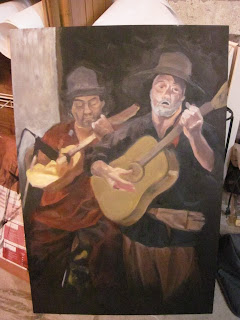
above: how to make a painting.
There are a lot of levels to this question so we'll tackle them the same way I tackle issues of painting: all at once, in no particular order, and with little efficacy. Essentially, you need an idea before you can make a painting, except when you're making the kind of painting whose idea takes shape through the construction process. You should start by making some sketches relating to your idea, unless you like the idea to come out of the sketch. Start by loosely sketching in areas. Start by making detailed tight compositional studies. Don't draw on your painting support. Make sketches on your painting support. Change everything so it doesn't resemble your sketch but perfectly embodies your concept, or decide that your concept has changed entirely yet the original form suits it.
You don't know what is going to happen. Start somewhere. You have to work but you owe it to yourself not to go insane. So start with what you can do.

I can do collages all day long. I gained an appreciation for the collage-- both as a working process and a fine art medium-- in Vicki Skinner's class at FAU. That was the first class to teach me to think critically about work as I am making it. It was also the first time I really got into the scissors, gluestick and xerox machine to work out compositions. That's how i made the image above- scaling and collaging original photos to fit the dimensions of my painting.

Once you've made your collage you can use it as a reference to make your painting. Even this process can be done a couple of ways. You can 'eyeball it', looking at the photo and matching it by sight. Or you can use some technology. The photo waaay up top is of my little projector (also known as my mom's projector... whatever). The photo immediately above is of a tracing made by enlarging and projecting my collage. It's faint and hard to see, but dead accurate.
Is it cheating to use tools and tech to make paintings? Evidence suggests the Old Masters didn't think so, or didn't care. Vermeer used a camera obscura to trace the drawings for his paintings. It's believed that's why they're so good! I am going to use another vintage painting trick on the above tracing: punching holes along the lines and rubbing charcoal into them to make a transfer.
 This is how my first painting is coming. In real life it looks less... diseased.
This is how my first painting is coming. In real life it looks less... diseased. Detail from above. Yeah, I know his eye is ... wrong...
Detail from above. Yeah, I know his eye is ... wrong...
Also! Sometimes I paint my nails lately. I don't know why but it makes me happy. The above have an orange and orange blossom design on a green background.

You have to do something. Do what you can. This is the moral of today's post and in keeping with this theme I am playing hooky from work. Where I come from, if you take a day off of work or school to go to the beach, you call it a "mental health day". Well, I had to take the day off to schedule and attend triage and counseling appointments. Shall we call it a "beach day"? Sounds like more fun.







